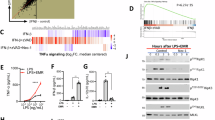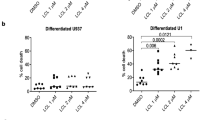Abstract
Cellular inhibitor of apoptosis proteins (cIAPs) have emerged as important anti-cell death mediators, particularly in cancer. Although they are known to be expressed in immune tissue, their specific immune function remains unclear. We observed that degradation of cIAPs with SMAC mimetic (SM) results in death of primary bone-marrow-derived macrophages. SM-induced death of macrophages occurred by programmed necrosis (necroptosis), which was dependent on TNF receptor expression. Consistent with necroptosis, SM-induced death of macrophages was abrogated by inhibition of receptor interacting protein 1 (Rip1) kinase signaling or by receptor interacting protein 3 (Rip3) knockdown. SM-induced necroptosis was also dependent on inhibition of SM-induced apoptosis due to the expression of the endogenous caspase inhibitor, xIAP. We found that cIAPs limit Rip3, and to a lesser extent Rip1, expression via post-transcriptional mechanisms, leading to inhibition of the Rip1–Rip3 death complex (necrosome). Reduced cIAP activity in vivo, via SM treatment or specific knockout of either cIAP, resulted in elevated macrophage cell death and compromised control of an intracellular bacterium, Listeria monocytogenes. These results show that cIAPs have an important role in limiting programmed necrosis of macrophages, which facilitates effective control of a pathogen.
Similar content being viewed by others
Log in or create a free account to read this content
Gain free access to this article, as well as selected content from this journal and more on nature.com
or
Abbreviations
- cIAP:
-
cellular inhibitors of apoptotic proteins
- xIAP:
-
x-linked inhibitor of apoptosis protein
- FLIP:
-
FLICE-like inhibitory protein
- SMAC:
-
second mitochondria-derived activator of caspases
- RIP:
-
receptor interacting protein
- TNF:
-
tumor necrosis factor
- Nec-1:
-
necrostatin-1
- ROS:
-
reactive oxygen species
- FADD:
-
Fas-associated death domain
- LM:
-
Listeria monocytogenes
- BMDMs:
-
bone-marrow-derived macrophages
References
Janeway C-AJ . How the immune system works to protect the host from infection: a personal view. Proc Natl Acad SciU SA 2001; 98: 7461–7468.
Jay Forman H, Torres M . Redox signaling in macrophages. Mol Aspects Med 2001; 22: 189–216.
Perlman H, Pagliari LJ, Georganas C, Mano T, Walsh K, Pope RM . FLICE-inhibitory protein expression during macrophage differentiation confers resistance to Fas-mediated apoptosis. J Exp Med 1999; 190: 1679–1688.
Mangan DF, Wahl SM . Differential regulation of human monocyte programmed cell death (apoptosis) by chemotactic factors and pro-inflammatory cytokines. J Immunol 1991; 147: 3408–3412.
Sordet O, Rebe C, Plenchette S, Zermati Y, Hermine O, Vainchenker W et al. Specific involvement of caspases in the differentiation of monocytes into macrophages. Blood 2002; 100: 4446–4453.
Christofferson DE, Yuan J . Necroptosis as an alternative form of programmed cell death. Curr Opin Cell Biol 2010; 22: 263–268.
Festjens N, Vanden Berghe T, Vandenabeele P . Necrosis, a well-orchestrated form of cell demise: signalling cascades, important mediators and concomitant immune response. Biochim Biophys Acta 2006; 1757: 1371–1387.
Degterev A, Huang Z, Boyce M, Li Y, Jagtap P, Mizushima N et al. Chemical inhibitor of nonapoptotic cell death with therapeutic potential for ischemic brain injury. Nat Chem Bio 2005; 1: 112–119.
Declercq W, Vanden Berghe T, Vandenabeele P . RIP kinases at the crossroads of cell death and survival. Cell 2009; 138: 229–232.
Mahoney DJ, Cheung HH, Mrad RL, Plenchette S, Simard C, Enwere E et al. Both cIAPI and cIAP2 regulate TNFalpha-mediated NF-kappaB activation. Proc Natl Acad Sci USA 2008; 105: 11778–11783.
He S, Wang L, Miao L, Wang T, Du F, Zhao L et al. Receptor interacting protein kinase-3 determines cellular necrotic response to TNF-[alpha]. Cell 2009; 137: 1100–1111.
Vanlangenakker N, Vanden Berghe T, Bogaert P, Laukens B, Zobel K, Deshayes K et al. cIAPI and TAK1 protect cells from TNF-induced necrosis by preventing RIP1/RIP3-dependent reactive oxygen species production. Cell Death Differ 2011; 18: 656–665.
Vandenabeele P, Declercq W, Van Herreweghe F, Vanden Berghe T . The role of the kinases RIP1 and RIP3 in TNF-induced necrosis. Sci Signal 2010; 3 re4.
Bertrand MJM, Milutinovic S, Dickson KM, Ho WC, Boudreault A, Durkin J et al. cIAP1 and cIAP2 facilitate cancer cell survival by functioning as E3 ligases that promote RIP1 ubiquitination. Mol Cell 2008; 30: 689–700.
Temkin V, Karin M . From death receptor to reactive oxygen species and c-Jun N-terminal protein kinase: the receptor-interacting protein 1 odyssey. Immunol Rev 2007; 220: 8–21.
Divangahi M, Chen M, Gan H, Desjardins D, Hickman TT, Lee DM et al. Mycobacterium tuberculosis evades macrophage defenses by inhibiting plasma membrane repair. Nat Immunol 2009; 10: 899–906.
Stockinger S, Decker T . Novel functions of type I interferons revealed by infection studies with Listeria monocytogenes. Immunobiology 2008; 213: 889–897.
Igney FH, Krammer PH . Death and anti-death: tumour resistance to apoptosis. Nat Rev Cancer 2002; 2: 277–288.
Yashi M, Muraishi O, Kobayashi Y, Tokue A, Nanjo H . Inhibitors of apoptosis proteins in prostate cancer cell lines. Prostate 2002; 51: 133–140.
Busca A, Saxena M, Kryworuchko M, Kumar A . Anti-Apoptotic genes in the survival of monocytic cells during infection. Curr Genomics 2009; 10: 306–317.
Lu J, Bai L, Sun H, Nikolovska-Coleska Z, McEachern D, Qiu S et al. SM-164: a novel, bivalent Smac mimetic that induces apoptosis and tumor regression by concurrent removal of the blockade of cIAP-1/2 and XIAP. Cancer Res 2008; 68: 9384–9393.
Roy N, Deveraux QL, Takahashi R, Salvesen GS, Reed JC . The c-IAP-1 and c-IAP-2 proteins are direct inhibitors of specific caspases. EMBO J 1997; 16: 6914–6925.
Eckelman BP, Salvesen GS . The human anti-apoptotic proteins cIAP1 and cIAP2 Bind but do not inhibit caspases. J Biol Chem 2006; 281: 3254–3260.
Degterev A, Hitomi J, Germscheid M, Ch'en IL, Korkina O, Teng X et al. Identification of RIP1 kinase as a specific cellular target of necrostatins. Nat Chem Biol 2008; 4: 313–321.
Suzuki Y, Nakabayashi Y, Nakata K, Reed JC, Takahashi R . X-linked inhibitor of apoptosis protein (XIAP) Inhibits caspase-3 and -7 in distinct modes. J Biol Chem 2001; 276: 27058–27063.
Cho YS, Challa S, Moquin D, Genga R, Ray TD . Phosphorylation-driven assembly of the RIP1-RIP3 complex regulates programmed necrosis and virus-induced inflammation. Cell 2009; 137: 1112–1123.
Lee TH, Shank J, Cusson N, Kelliher MA . The kinase activity of Rip1 is not required for tumor necrosis factor-alpha-induced IkappaB kinase or p38 MAP kinase activation or for the ubiquitination of Rip1 by Traf2. J Biol Chem 2004; 279: 33185–33191.
Feoktistova M, Geserick P, Kellert B, Dimitrova DP, Langlais C, Hupe M et al. cIAPs block ripoptosome formation, a RIP1/caspase-8 containing intracellular cell death complex differentially regulated by cFLIP isoforms. Mol Cell 2011; 43: 449–463.
Mocci S, Dalrymple SA, Nishinakamura R, Murray R . The cytokine stew and innate resistance to L. monocytogenes. Immunol Rev 1997; 158: 107–114.
Cui X, Imaizumi T, Yoshida H, Tanji K, Matsumiya T, Satoh K . Lipopolysaccharide induces the expression of cellular inhibitor of apoptosis protein-2 in human macrophages. Biochim Biophys Acta 2000; 1524: 178–182.
Muller-Sienerth N, Dietz L, Holtz P, Kapp M, Grigoleit GU, Schmuck C et al. SMAC mimetic BV6 induces cell death in monocytes and maturation of monocyte-derived dendritic cells. PLoS ONE 2011; 6: e21556.
Kaiser WJ, Upton JW, Long AB, Livingston-Rosanoff D, Daley-Bauer LP, Hakem R et al. RIP3 mediates the embryonic lethality of caspase-8-deficient mice. Nature 2011; 471: 368–372.
Oberst A, Dillon CP, Weinlich R, McCormick LL, Fitzgerald P, Pop C et al. Catalytic activity of the caspase-8-FLIP(L) complex inhibits RIPK3-dependent necrosis. Nature 2011; 471: 363–367.
Eckelman BP, Salvesen GS, Scott FL . Human inhibitor of apoptosis proteins: why XIAP is the black sheep of the family. EMBO Rep 2006; 7: 988–994.
Tenev T, Bianchi K, Darding M, Broemer M, Langlais C, Wallberg F et al. The ripoptosome, a signaling platform that assembles in response to genotoxic stress and loss of IAPs. Mol Cell 2011; 43: 432–448.
Probst BL, Liu L, Ramesh V, Li L, Sun H, Minna JD et al. Smac mimetics increase cancer cell response to chemotherapeutics in a TNF-alpha-dependent manner. Cell Death Differ 2010; 17: 1645–1654.
Wu H, Tschopp J, Lin SC . Smac mimetics and TNFalpha: a dangerous liaison? Cell 2007; 131: 655–658.
Davis CW, Hawkins BJ, Ramasamy S, Irrinki KM, Cameron BA, Islam K et al. Nitration of the mitochondrial complex I subunit NDUFB8 elicits RIP1- and RIP3-mediated necrosis. Free Radic Biol Med 2010; 48: 306–317.
Prakash H, Becker D, Böhme L, Albert L, Witzenrath M, Rosseau S et al. cIAP-1 controls innate immunity to C. pneumoniae pulmonary infection. PLoS ONE 2009; 4: e6519.
Conte D, Holcik M, Lefebvre CA, LaCasse E, Picketts DJ, Wright KE et al. Inhibitor of apoptosis protein cIAP2 Is essential for lipopolysaccharide-induced macrophage survival. Mol Cell Biol 2006; 26: 699–708.
Kenneth NS, Younger JM, Hughes ED, Marcotte D, Barker PA, Saunders TL et al. An inactivating caspase-11 passenger mutation originating from the 129 murine strain in mice targeted for c-Iap1. Biochem J 2012; 443: 355–359.
Kayagaki N, Warming S, Lamkanfi M, Vande WL, Louie S, Dong J et al. Non-canonical inflammasome activation targets caspase-11. Nature 2011; 479: 117–121.
Upton JW, Kaiser WJ, Mocarski ES . Virus inhibition of RIP3-dependent necrosis. Cell Host Microbe 2010; 7: 302–313.
Conze DB, Albert L, Ferrick DA, Goeddel DV, Yeh WC, Mak T et al. Posttranscriptional downregulation of c-IAP2 by the ubiquitin protein ligase c-IAP1 in vivo. Mol Cell Biol 2005; 25: 3348–3356.
Acknowledgements
This work was supported by grants from the Canadian Institutes of Health Research (SS) and the Ontario Institute for Cancer Research (LK).
Author information
Authors and Affiliations
Corresponding author
Ethics declarations
Competing interests
The authors declare no conflict of interest.
Additional information
Edited by A Villunger
Supplementary Information accompanies the paper on Cell Death and Differentiation website
Supplementary information
Rights and permissions
About this article
Cite this article
McComb, S., Cheung, H., Korneluk, R. et al. cIAP1 and cIAP2 limit macrophage necroptosis by inhibiting Rip1 and Rip3 activation. Cell Death Differ 19, 1791–1801 (2012). https://doi.org/10.1038/cdd.2012.59
Received:
Revised:
Accepted:
Published:
Issue date:
DOI: https://doi.org/10.1038/cdd.2012.59
Keywords
This article is cited by
-
Cellular inhibitor of apoptosis 2 (cIAP2) restricts neuroinflammation during experimental autoimmune encephalomyelitis
Journal of Neuroinflammation (2022)
-
Targeting necroptosis in muscle fibers ameliorates inflammatory myopathies
Nature Communications (2022)
-
The IAP Antagonist SM-164 Eliminates Triple-Negative Breast Cancer Metastasis to Bone and Lung in Mice
Scientific Reports (2020)
-
Loss of Microglial Parkin Inhibits Necroptosis and Contributes to Neuroinflammation
Molecular Neurobiology (2019)
-
Combination therapy with proteasome inhibitors and TLR agonists enhances tumour cell death and IL-1β production
Cell Death & Disease (2018)



